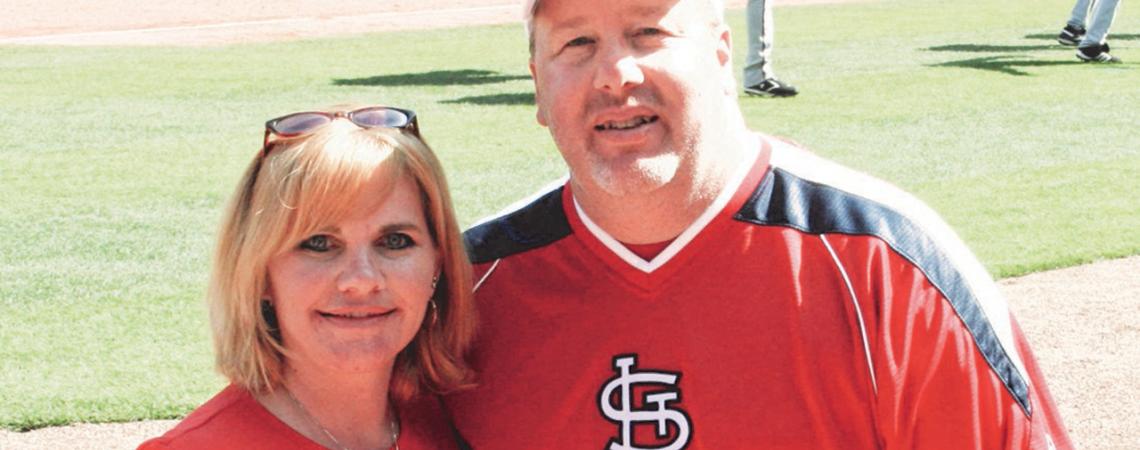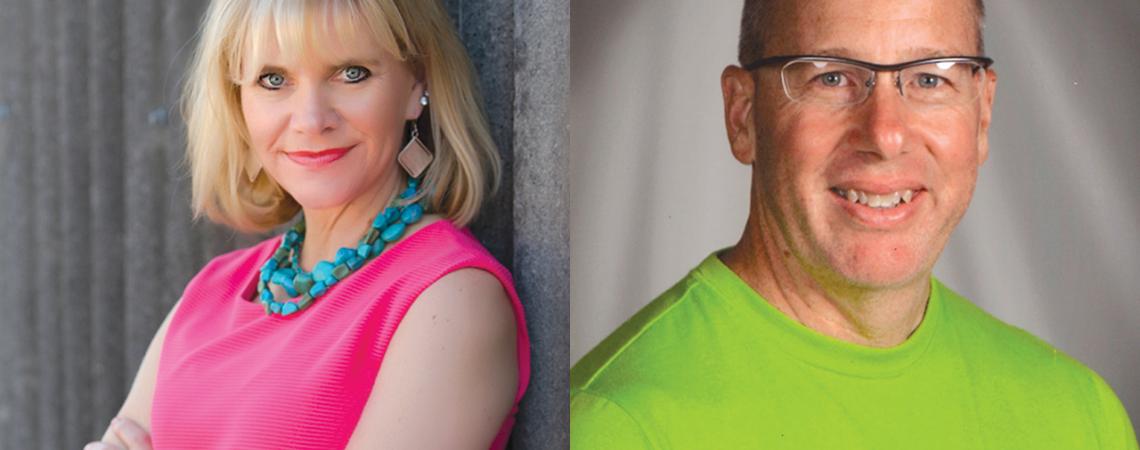When I was younger, I was the girl who hated physical education, didn’t play sports, and ate a steady diet of junk food. Because I was young, I had no health concerns or weight issues.
How things change. As I got older, I gained weight. I was tired all the time. Though I tried to make light of it — at 5 foot 2 and 174 pounds, I’d say things like, “I’m not overweight, I’m undertall” — I guess the joke was on me. Eventually, the scale tipped closer to 200 pounds than the 126 still on my driver’s license.
Author Lisa Rigoni and her husband, Mike, before their fitness journey.
My husband, Mike, a physical education teacher and a basketball coach at the time, was in a similar boat. When Mike and I met, he was active, playing softball, and later, he played men’s recreational basketball until his legs and ankles got the better of him. His weight had increased, and that led to surgeries on his knee and ankles. He was benched for a while and when he returned to the basketball court, he was overweight and run-down, often with barely enough energy to get through the day.
We ate fast food. Most of our meals came from a box, a bag, the freezer, or a drive-through. It was mostly processed food, full of sugar and fat, and it was easy and cheap.
We loved it.
Ready for change
I realized later that the big, bulky shirts and stretchy pants I wore didn’t just hide those extra pounds; I added layers to help cover my sadness, anger, resentment, food addiction, and more.
Finally, my husband began seeing a new doctor, who had a fresh approach. The doctor asked him directly, “Are you leading by example?” referring to how he was living in front of his students and players — those he was teaching and coaching toward healthy lifestyles.
That question clicked in his head, and his transformation began that night. He joined a gym and cleared our kitchen of junk food, replacing it with healthier, whole foods. We started eating at home — more salads, fruits and vegetables, lean meat — and even when we ate fast food, Subway became his choice. There was no magic formula or pill. It was hard work, discipline, and an intentional new mindset.
Reality check
That single question was his reality check. As hard as it was to swallow, so are the national statistics. The U.S. has one of the highest rates of obesity in the world. According to reports from the National Centers for Disease Control and Prevention (CDC), nearly 40% of adults (almost 94 million) and 18.5% (13.7 million) of children and adolescents in this country are obese.
The CDC estimates if things don’t change by 2030, half of U.S. teenagers and a third of kids between 6 and 11 will be overweight or obese.
Poor health also has a surprising effect on the economy. According to the CDC, an obese person in America incurs an average of $1,429 more in medical expenses every year than those who are not obese. More than $147 billion is spent on those added medical expenses annually within the U.S., and that number keeps growing. Insurance costs continue to rise, in general, but add obesity-related diseases to the mix — strokes, asthma, heart attacks, and other cardiovascular diseases, to name a few — and the cost increases even more.
Change your mindset
It doesn’t have to be that way. Some months after Mike stepped up to make changes — but before I did — we were at dinner with my coworkers when someone asked him how much weight he had lost. I was busily chatting with someone else when I heard him respond, “About 50 pounds.” I spun around, shocked. “You’ve lost 50 pounds?” He just smiled. I knew he had made changes, but seeing him every day, I hadn’t truly noticed the physical results.
How did he do it? He changed the way he thought. He made better food choices and added exercise.
Healthy starts from the inside out. It starts with small steps and changing your thought patterns. Start by writing down your health goals. Make them SMART: specific, measurable, attainable, realistic, and time-based (e.g., I will lose 15 pounds by Easter, or exercise three to five days a week).
I grudgingly started going to the gym with him, but only in a neighboring town so I wouldn’t run into people I knew. I was afraid I’d make a fool of myself.
I was sure I would fly off a treadmill, drop a dumbbell on my head, or do something worse. What we worry about or envision as obstacles often get in the way of what is possible.
Rewards for healthy living
Soon, I began enjoying my workouts and made healthier food choices and created good habits. I lost more than 40 pounds and have kept it off. My energy levels climbed. My attitude shifted from negative to positive. Suddenly, I was an example of good physical health, and people at the gym started asking for my help.
Are you ready to move forward? The best thing to do is just to start — start now — and remember to believe in yourself. If you think you can, you’re right. If you think you can’t, you’re right. Believe you can make a change, develop a plan, and go get it.
Nutrition is key to good health
It seems so obvious. When you get a car, you regularly make sure the engine is clean and running on all cylinders. You clean filters and check plugs and battery connections. You change the oil, make sure other liquids are properly filled, and check and inflate the tires to the appropriate pressure. You fill the tank with a specific grade of gasoline to increase its efficiency. You might even use all premium products.
Your body is also an intricate system that needs the right kind of fuel to run properly. Good nutrition is the place to start, and it isn’t as difficult as we often make it. Guidelines set by the Food and Drug Administration are fairly simple, and there are practical ways to make healthy choices.
- Fill your plate with vegetables and fruits. Choose from a rainbow of bright colors: red, orange, green, purple, and yellow. They are full of nutrients to help boost your energy.
- Include lean proteins, such as beef, chicken, pork, turkey, even beans and tofu. Twice a week, make seafood your choice of protein.
- Get your calcium. Drink a cup of fat-free or low-fat milk. You’ll benefit from the same amount of calcium with fewer calories and less fat.
- Make half your grains whole grains.
- Use healthy fats such as canola oil, olive oil, and nonstick vegetable spray for cooking.
- Replace sweets with plain fruit — strawberries, apples, orange slices. Can’t find fresh fruit? It’s okay to grab frozen or canned, but be sure they aren’t in syrup. Get produce in its most natural state.
- Exchange chips and dip for veggies and dip. Fresh veggies are always best, but in colder months, it’s not always possible.
- Use spices and herbs to flavor your foods, rather than adding sugar and salt.
- Prepare foods in advance so you don’t grab convenience foods that aren’t as healthy.
- Read the nutrition label.
Lisa Templeton Rigoni is a certified fitness trainer who has a passion for fitness and life balance. She can be reached by email or through her website.











